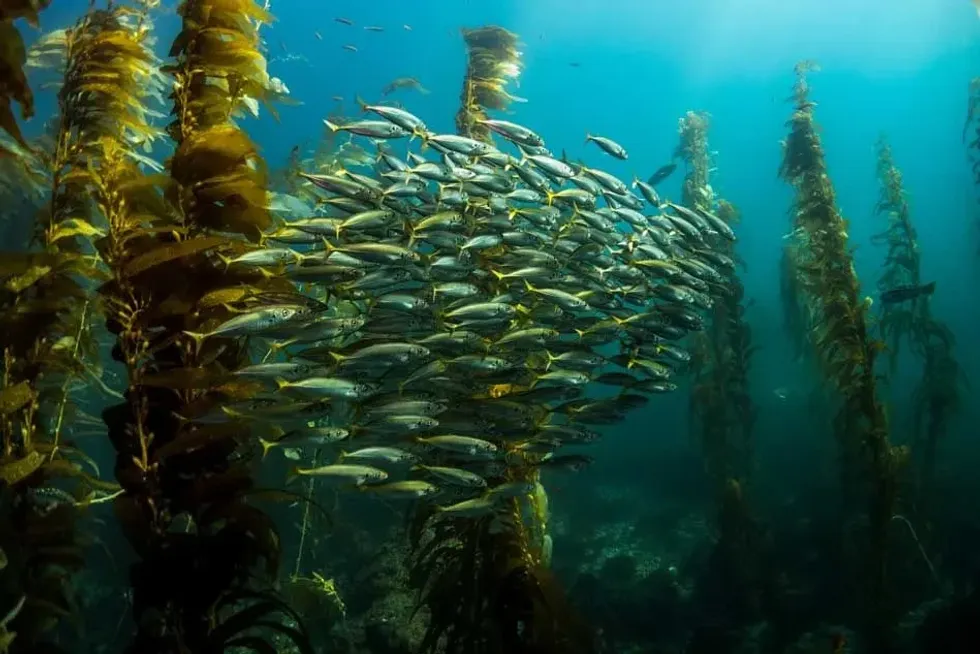Spanish mackerels (Scomberomorus maculatus) are a migrating species of mackerel. During the spring season, they swim to the Mexican Gulf in the north and return in the fall to the Eastern Gulf of South Florida and Mexico's Western Gulf.
However, they can be found in pretty much every ocean. They are fast swimmers and can be seen in large schools. Spanish mackerel can be identified with its long, bullet-shaped body, silver color, a shade of green at the top, and yellowish elliptical spots on its sides.
They are covered with minute scales. Spanish mackerel's flavor is rich and distinct.
Recreational fishers and commercial fisheries enjoy fishing mackerel as they are very energetic and fast swimmers, and it is very difficult to catch them.
Spanish mackerel spend winter off along the Atlantic coast and swim Far north towards North Carolina in the month of April and to New York in the month of June. Later in the year, during the winter season, they return to the Gulf of south Florida's water.
If you liked these true facts about Spanish mackerel, then you'll surely like these facts about codfish and milkfish too!
Spanish Mackerel Interesting Facts
What type of animal is a Spanish mackerel?
Spanish mackerel is a fish in the Animalia kingdom. They are migrating species of mackerel and are bullet-shaped, silvery in color with a greenish top and yellowish elliptical spots on their side, with minute scales. They are similar to tuna and other mackerels.
What class of animal does a Spanish mackerel belong to?
Spanish mackerel belongs to the class of Actinopterygii as they are one of the ray-finned fishes.
How many Spanish mackerels are there in the world?
Spanish mackerel are managed in the commercial fisheries and recreational fishing because the population used to be in decline, but after proper management, it is now on the rise without overfishing.
Where does a Spanish mackerel live?
These species are found mostly all across the globe, they prefer shallow waters and the bottom of the ocean.
What is a Spanish mackerel's habitat?
Spanish mackerel are species found in shallow water and they prefer the sand bottom of 10-40 ft (3-12 m) and are found often in waters at depths of 80 ft (24 m) occasionally.
Spanish mackerel inhabit the South Florida waters, whereas, with rising temperature in water, the groups in the Atlantic migrate along the coast of Miami, Florida, in the US in search of a new habitat.
Who do Spanish mackerels live with?
Spanish mackerel are normally found in large schools. A Spanish Mackerel lures its prey by clamping them outside the water while feeding on them.
How long does a Spanish mackerel live?
On average, a female can live up to 12 years and grow up to 13 lb (5.8 kg), whereas the males only live up to the age of 6. They live in large schools.
How do they reproduce?
Spanish Mackerel can reproduce by the age of two, they lay up to 500,000- 1.5 million eggs over a spawning season. The spawning season for Spanish mackerel starts in April and lasts till September on the Virginia coasts in the Atlantic Ocean and North Carolina and in flimsy coastal waters of the Eastern Gulf of Mexico.
What is their conservation status?
As per IUCN, Spanish mackerel are marked as a Least Concern species. During the early 1980s, when the fishery was unregulated, they were heavily fished by commercial fisheries and recreational fishermen, due to which the stocks were below the target level. And today, their population is above the target level.
Spanish Mackerel Fun Facts
What do Spanish mackerels look like?

Spanish mackerels have a bullet-shaped body, silver color with a greenish top and yellowish spots on their sides. Their hindmost fins are by far black in color in the front region.
The membranes at the back, however, sport a white color with a black edge. Spanish mackerel teeth are large and uniform (around sixty-four teeth in all), flattened from side to side and closely shaped. They have similar teeth, just as King Mackerel and Cero Mackerel.
How cute are they?
Spanish Mackerel would not be termed as "cute". However, the bullet-shaped silvery color makes them look elegant.
How do they communicate?
All fishes have otoliths consisting of a sensory epithelium which is made up of calcareous otoliths and their hair cell.
How big is a Spanish mackerel?
They are powerful and blistering swimmers. The largest Spanish mackerel ever caught was over 72 in (182.88 cm) long and weighed around 120 lb (54.43 kg).
Females live longer than males and grow to a larger size than males. The average size of a mature Spanish mackerel is 28 in (71.12 cm).
How fast can a Spanish mackerel swim?
Spanish mackerel are blistering and agile swimmers and can swim up to 5.5 ms (0.0055 kps) and can stretch up to 20 mi (32.18 km) when they swim.
How much does a Spanish mackerel weigh?
Spanish Mackerel (Scomberomorus maculatus) can grow to an average size of 8-11 lb (4-5 kg). Juvenile mackerel flourish rapidly but then start to flourish slowly when they reach the age of five years. Sizes of Spanish Mackerel can vary at sexual maturity based on area and sex. Female mackerel are heavier than males.
What are their male and female names of the species?
Spanish mackerel belongs to the family Scombridae. However, different names for males and females of the species are not given.
What would you call a baby Spanish mackerel?
Unfortunately, a baby Spanish mackerel has not been given a specific name and is known as a baby or a small Spanish mackerel.
What do they eat?
Spanish mackerel mainly prey on sardines, needlefish, herring, mullet, anchovy, menhaden, shrimps, and squids. Mackerels are seen forcing schools of small fish to clump together, pushing outside the waters while feeding on them.
Are they eaten by humans?
Yes, Spanish mackerel can be cooked in various methods, such as baking, smoking, steaming, grilling, frying, and poaching. Japanese Spanish Mackerel, coming from the same genus, is one of the most famous sushi fish ingredients, as they contain omega-3 fatty acids which are important in a person's diet.
Their raw meat is white in color, and also they are the tastiest of the mackerel species. The Spanish mackerel taste is very mild in flavor with light oil and it has a slightly acidic note.
Their raw meat is white in color, and it's extremely firm when cooking. The Spanish mackerel texture crumbles into small chunks.
Would they make a good pet?
Humans do not domesticate the Spanish Mackerel. And they are not ideal for keeping as pets as they need big open oceans and plenty of food.
Did you know...
Narrow-barred Spanish mackerel are in the far west on the east coast of Africa and from the Middle East along with the northern coastal areas of the Indian Oceans
The key feature that differentiates the Spanish mackerel from the king mackerel is that the first dorsal fin of a Spanish mackerel is black in color, whereas king mackerel's first dorsal fin is lightly colored across its extent.
King mackerel are high in mercury compared to Spanish mackerel, and Spanish mackerel mercury levels from the Gulf of Mexico are much higher than the Spanish mackerels in the Atlantic Oceans.
Spanish mackerel (Scomberomorus maculatus) is a favorite fishing target, making them a quintessential choice of prey for all fisheries.
Their first dorsal fin has 17-19 spines originating above the pectoral fins base.
Due to management, there has been a restriction on fishing mackerel smaller than 12 in (30.48 cm), and you can keep only up to 15 mackerels, too.
To catch a mackerel via fishing, you will need light to medium spinning tackle, strong braided lines, a medium fishing rod that is 7-8 ft (21-2.4 m) long, and 1/0-2/0 circle hooks that match the bait. For bait, you can use live shrimp and small fish like sardines, mullets, or even small pieces of squids.
Catching Spanish Mackerel needs lots of energy as they are one of the fastest swimmers in the ocean. Atlantic Ocean Mackerel are different from mackerel in the Gulf of Mexico.
What is the minimum size of Spanish mackerel you are allowed to catch?
The Spanish mackerel size limit that is allowed to catch is 12 in (30.48 cm) fork length as it would be illegal for any person fishing to catch or possess a fish less than the permissible size.
When do Spanish mackerel migrate?
Spanish mackerels are migratory species of mackerels, Spanish mackerels fish migrate during the spring season they swim to the Northern Gulf of Mexico and return in the falls to the eastern Gulf of south Florida and to Mexico in the western gulf.
Here at Kidadl, we have carefully created lots of interesting family-friendly animal facts for everyone to discover! Learn more about some other fish including yellowfin tuna, or skipjack tuna.
You can even occupy yourself at home by drawing one on our spanish mackerel coloring pages.










